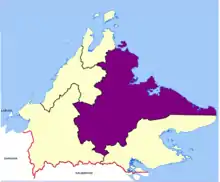Sandakan Division
Sandakan Division (Malay: Bahagian Sandakan) is an administrative division of Sabah, Malaysia. It stretches diagonally from the northeastern coast of Sabah to the state's central region. With an area of 28,205 square kilometres, it occupies 38.3% of Sabah's territory, and is thus the largest of the five administrative divisions of Sabah. It also has approximately 19.4% of Sabah's total population,[1] with the major inhabitants comprising the Chinese, Orang Sungai, Kadazan-Dusun, Suluk and Bajau Simunul.[2]

The main towns are Sandakan, Beluran, Kinabatangan, Telupid and Tongod. Sandakan port is the second largest after Kota Kinabalu. The port serves as a major timber export gateway.[3] The Sandakan Airport serves the Sandakan division.[1]
Districts
Sandakan Division is subdivided into the following administrative districts:[1]
- Beluran District (8,345 km2) (Beluran Town)
- Kinabatangan District (8,000 km2) (Kinabatangan Town)
- Sandakan District (2,266 km2) (Sandakan Town)
- Telupid District (1,935 km2) (Telupid Town)
- Tongod District (10,052 km2) (Tongod Town)
Member of Parliament (Dewan Rakyat)
| Parliament | Member of Parliament | Party |
|---|---|---|
| P183 Beluran | Ronald Kiandee | PN (PPBM) |
| P184 Libaran | Zakaria Edris | PN (PPBM) |
| P185 Batu Sapi | Vacant | VAC |
| P186 Sandakan | Vivian Wong Shir Yee | PH (DAP) |
| P187 Kinabatangan | Bung Mokhtar Radin | BN (UMNO) |
History
The present divisions of Sabah is largely inherited from the division of the North Borneo Chartered Company. Following the acquisition of North Borneo under the royal charter issued in 1881, the administrative division introduced by Baron von Overbeck was continued by the establishment of two residences comprising West Coast Residency and East Coast Residency. Seat of the two residents was in Sandakan, where the governor was based. Each resident, in turn, was divided into several provinces managed by a district officer.[note 1][4]
As North Borneo progresses, the number of residencies has increased to five including: Tawau Residency (also known as East Coast Residency), Sandakan Residency, West Coast Residency, Kudat Residency, and Interior Residency; the provinces were initially named after the members of the board: Alcock, Cunlife, Dewhurst, Keppel, Dent, Martin, Elphinstone, Myburgh and Mayne. The senior residents occupied Sandakan and the West Coast, while the other three resident with the second class residencies occupied Interior, East Coast and Kudat. The residents of Sandakan and West Coast were members of the Legislative Council, the Legislative Assembly of the Company.[5]
The division into residencies was maintained when North Borneo became a Crown Colony after World War II. On 16 September 1963, with the formation of Malaysia, North Borneo which subsequently became the state of Sabah took over the administrative structure through the Ordinance on Administrative Units. At the same time, the Yang di-Pertua Negeri, the head of state of Sabah, was authorised by proclamation to divide the state into divisions and districts.[note 2] The abolition of the residency term was in favour of the division term that took place in 1976.[6]
Today, the division has only formal significance and no longer constitutes its own administrative level. The resident's post was also abolished, as Sabah's municipal administration is in the hands of the district officers.
See also
Notes
- The original position was initially Magistrates-in-charge.
- The most recent such proclamation dates from 2009: Administrative Divisions Proclamation 2009.
Literature
- Tregonning, K. G. (1965). A History Of Modern Sabah (North Borneo 1881–1963). University of Malaya Press.
References
- "General Information". Lands and Surveys Department of Sabah. Borneo Trade. Retrieved 1 November 2017.
- Xiang Ting Goh; Yvonne AL Lim; Indra Vythilingam; Ching Hoong Chew; Ping Chin Lee; Romano Ngui; Tian Chye Tan; Nan Jiun Yap; Veeranoot Nissapatorn; Kek Heng Chua (2013). "Increased detection of Plasmodium knowlesi in Sandakan division, Sabah as revealed by PlasmoNex™ (Methods: Study area and population)". Malar J. US National Library of Medicine, National Institutes of Health. 12: 264. doi:10.1186/1475-2875-12-264. PMC 3733977. PMID 23902626.
- Vern Bouwman (2004). Navy Super Tankers. Trafford Publishing. pp. 270–. ISBN 978-1-4120-3206-3.
- Tregonning 1965, pp. 51.
- Owen Rutter (1922). "British North Borneo - An Account of its History, Resources and Native Tribes". Constable & Company Ltd, London. Internet Archive. p. 157. Retrieved 3 November 2017.
- "Interpretation and General Clauses Enactment 1963 [Enactment No. 19/1978] — valid from 1 January 1979" (PDF). Sabah State Attorney's General Chambers. 1963. Retrieved 3 November 2017.
Further reading
- State of Sabah: Administrative Divisions Ordinance – Sabah Cap. 167 (PDF) of 1 November 1954; last amended on 16 September 1963, as amended in August 2010; Accessed on 3 November 2017